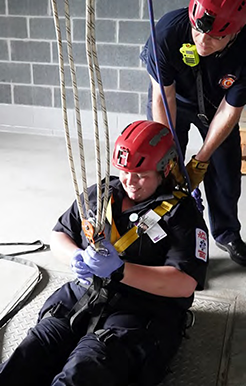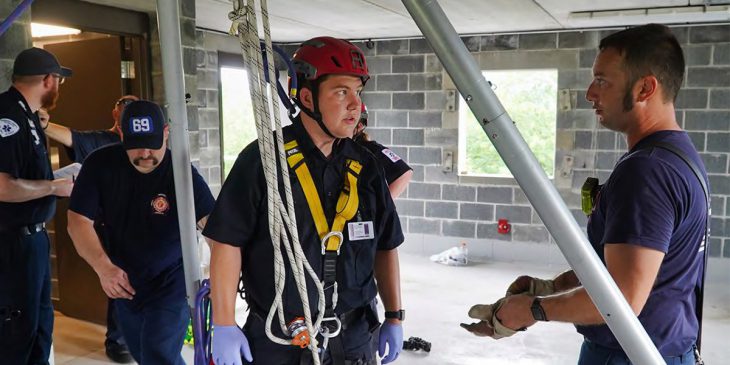Emergency Medical Services (EMS) providers are the first step in providing world-class care throughout UPMC’s system.
“If there is not an effective partnership and teamwork with EMS, and a clear link with those who can see people as quickly as possible after the onset of a trauma or symptoms, we lose a valuable opportunity to improve health,” said Dr. Donald Yealy, chief medical officer of UPMC. “It’s as simple as that.”
Positive outcomes are a direct result of the relationship between EMS and their Emergency Department (ED) counterparts. “The interaction relies on continuity — from the first 911 call through the time the patient is brought to the ED,” said Shannon Adams, interim fire chief, Cumberland, Maryland. “Communicating what treatment is happening in the field is key to ensure staff at the hospital are prepared for what is coming in.”

Community LifeTeam EMS members participate in scenarios developed for their stress induced competency assessment
At UPMC Hamot in Erie, Pennsylvania, the ED has adopted a “20-second shout out for trauma.” When EMS enters the trauma bay with a patient, the entire UPMC team will remain silent in order to receive critical information and to show respect for the emergency medical technicians (EMTs) bringing the patient in. “This was developed a few years ago, and it has been so successful it has become a statewide program with UPMC at the forefront of its development,” said Don Holsten, senior manager of hospital care at UPMC Hamot.
The transport team at UPMC Children’s Hospital of Pittsburgh also relies heavily on the information they receive from EMS. “What EMS provides us is essential,” said Karen Luksis, respiratory therapist. “They give us critical updates about the care they provided both on site and enroute to the hospital.”
That information is especially important when dealing with young patients. “The infant population can be complicated to provide care for,” said Mark Westerman, R.N., UPMC Children’s transport team. “There is a lot of equipment and technology involved. It is both physically and intellectually heavy.”
Seven UPMC hospitals are served by Community LifeTeam EMS, a UPMC-designed EMT and paramedic staff with about 300 dedicated providers. For the last two years, the team has operated its own training academy to continue to put highly skilled and trained workers into the UPMC pipeline.
“When you have a need, why not create the supply?” said Craig Skurcenski, vice president, Emergency Medicine, UPMC in Central Pa. “The idea stemmed from a desire to recruit, train and retain our own personnel in a manner that was attractive to the workforce and in a functional capacity that allowed us to create the type of employee we want to have.”
Community LifeTeam EMS covers 86 municipalities in central Pennsylvania, including Harrisburg and York.
“We bring together individuals of many different backgrounds who have chosen EMS as a future career with UPMC,” said Bret Mitchell, education coordinator, Community LifeTeam EMS. “They are hired and paid to learn how to become an EMT.”
The 10-week curriculum begins in the classroom with a basic introduction that progresses to more advanced topics, like CPR on unconscious patients and technical rescues. Next comes clinical experience in the field and, after passing their tests, they are placed on ambulances as professional EMTs.
To learn more about EMS career opportunities at UPMC, visit UPMC-Careers.








